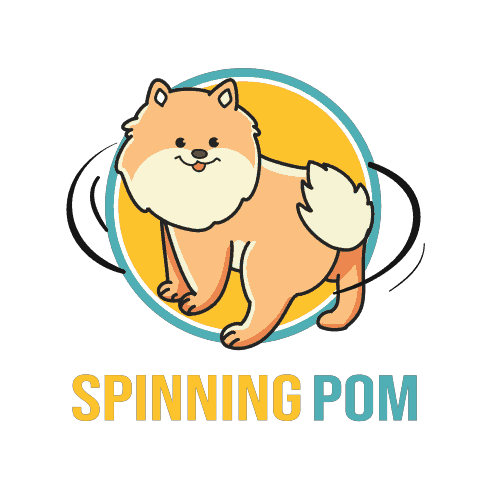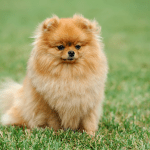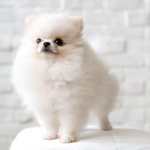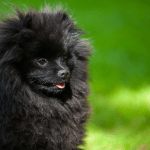Teacup Pomeranians are known for their fluffy, soft coats in white, orange, red, sable, black, and chocolate. Their teddy bear look makes them irresistible. Their cute ears and smart gaze add to their appeal. To avoid matting, Teacup Pomeranians need routine grooming.
Teacup Pomeranians are loving and playful. They love affection and their owners. They are smart and trainable dogs that can learn many tricks and orders. They need daily exercise due to their high energy levels. Teacup Pomeranians are adorable, lively, and caring dogs that make great pets.
History and Characteristics of Teacup Pomeranians
Miniature versions of the Pomeranian dog type, known as teacup Pomeranians, are thought to have evolved in what is now German- and Polish-occupied Pomerania in Europe. The American Kennel Club (AKC) officially acknowledged the species in the year 1900, and since then, it has spread throughout the globe.
Teacup Pomeranians are known for their welcoming and outgoing personalities. They are well-liked for being friendly and lively pets who take pleasure in their owners’ company. They are highly perceptive canines who enjoy getting out and about and interacting with the world around them. However, due to their diminutive stature, they should be closely monitored whenever they are in the company of kids or other animals.
One more thing that teacup Pomeranians are famous for is their ability to adjust to new environments. They are adaptable to city or suburban dwellings, as well as to sharing their space with other creatures and young people. To maintain health and happiness, however, they need frequent physical activity and cerebral stimulation. When they aren’t receiving the attention they need, Teacup Pomeranians are known to bark or whimper.
How big does a tiny Pomeranian grow?
Pomeranians are a small dog breed that usually weighs between 3 and 7 pounds and stands 6-7 inches tall at the shoulder. As “toy” breeds, Pomeranians are known for being small, but how big can a small Pomeranian get?
It’s important to remember that Pomeranians grow in different ways depending on things like their genes, diet, surroundings, and exercise. Even though they are small and weak when they are born, they can grow quickly during the puppy and teen years.
Overall, a Pomeranian’s size will change based on its gender, genes, and other things in its surroundings. It’s important to keep an eye on their growth and talk to a vet if you’re worried about their size or health in general.
Temperament of Teacup Pomeranian
While Pomeranians—and particularly teacup Pomeranians—may be small in stature, their big dispositions more than make up for their diminutive size. These minuscule beings are full of life, joy, and bravery. This spriteliness can sometimes manifest in a canine that is excessively barky and nervous around strangers. This is because they are extremely devoted to their master and feel threatened when anyone else attempts to interact with them.
It is essential to associate a Teacup Pomeranian with people and other dogs to help reduce its possessive and territorial behaviors. Therefore, a Teacup Pomeranian’s owner should keep a close eye on their pup around other canines, particularly those that are significantly larger than their Teacup Pom. Pomeranians are oblivious to their diminutive stature, and as a result, they occasionally engage in battles they have no chance of winning.
Because of their yappy disposition, Pomeranians can serve well as watchdogs. You need to be careful, though, that this impulse doesn’t get out of hand. With the right amount of socialization and training, a Teacup Pomeranian can develop into a bright and attentive pet that will keep you amused and laughing for years to come.
Coat & Colors
Pomeranians are known for their fluffy and soft coats, which consist of two layers: a short, dense undercoat and a longer, coarser topcoat. The coat requires regular grooming to prevent matting and tangles, but it is relatively easy to maintain with regular brushing.
Pomeranians come in a variety of colors, including black, white, orange, cream, sable, and brindle. Some Pomeranians may also have party coloring, which is a combination of two or more colors.
The color of a Pomeranian’s coat is determined by genetics, and certain colors may be rare or more desirable than others. It’s important to note that coat color should not be the sole factor when choosing a Pomeranian, as temperament and health should also be considered.
Exercise & Living Requirements
While Pomeranians are small dogs, they still require regular exercise to stay healthy and happy. A daily walk or play session can help to keep them active and prevent boredom. However, it’s important to be mindful of their size and not over-exert them, as they can become tired or overheat quickly.
In terms of living requirements, Pomeranians can adapt to various living situations, including apartments or smaller homes. They do not require a lot of space to be happy, but it’s important to provide them with a safe and comfortable living environment.
It’s also important to note that Pomeranians are social animals and enjoy spending time with their owners. They may become anxious or bored if left alone for long periods of time, so it’s important to provide them with plenty of attention and mental stimulation.
Nutrition
A healthy diet is essential for the overall health and well-being of Pomeranians, including teacup Pomeranians. It’s important to provide them with a balanced diet that includes high-quality protein, healthy fats, and essential vitamins and minerals.
Commercial dog food can be a convenient and affordable option, but it’s important to choose a high-quality brand that uses natural, whole-food ingredients and doesn’t contain artificial preservatives or fillers. Many Pomeranian owners also choose to feed their dogs a raw or homemade diet, but it’s important to work with a veterinarian or canine nutritionist to ensure that the diet is balanced and meets their nutritional needs.
It’s also important to be mindful of portion sizes and avoid overfeeding, as Pomeranians can be prone to obesity. Providing them with regular exercise and limiting treats can help to prevent weight gain and promote overall health.
Grooming
Proper grooming is important for the health and appearance of Pomeranians, including teacup Pomeranians. Their thick, double coat requires regular brushing and grooming to prevent matting and tangling, and to maintain its softness and shine.
Teacup Pomeranians, in particular, may require more frequent grooming due to their smaller size and more delicate coats. Daily brushing can help to prevent matting and tangling, while regular bathing can help to keep their coat clean and free of dirt and debris.
In addition to regular brushing and bathing, it’s important to keep their nails trimmed to prevent them from becoming too long and causing discomfort or potential injury. Regular teeth brushing and dental care are also important to prevent dental problems and keep their breath fresh.
Some Pomeranian owners choose to take their dogs to professional groomers for haircuts and styling, while others prefer to groom their dogs at home. It’s important to use gentle, dog-friendly grooming products and to handle your dog with care to avoid causing them discomfort or injury.
How long do Teacup Pomeranians live?
Teacup Pomeranians can have a lifespan of anywhere from 12 to 16 years, with some living even longer. However, their lifespan can be affected by a variety of factors, including genetics, diet, exercise, and overall health.
Teacup Pomeranians, in particular, may be more prone to certain health issues due to their small size, such as dental problems, collapsed trachea, and hypoglycemia. Providing them with regular veterinary care and a healthy diet can help to minimize the risk of these issues and extend their lifespan.
It’s important to note that while Teacup Pomeranians are small and delicate, they still require the same level of care and attention as a standard-sized Pomeranian. Providing them with proper care and attention can help to ensure that they live a long and happy life.
What is the price of a Pomeranian?
The price of a Pomeranian can vary widely depending on a variety of factors, such as the dog’s age, gender, coat color, and lineage. Generally, you can expect to pay anywhere from a few hundred dollars to several thousand dollars for a Pomeranian puppy.
It’s important to note that while purchasing a Pomeranian from a reputable breeder may cost more initially, it can help to ensure that you are getting a healthy and well-socialized dog. Additionally, adopting a Pomeranian from a shelter or rescue organization can be a more affordable option, with adoption fees typically ranging from $50 to $500.
It’s important to do your research and find a reputable breeder or rescue organization to ensure that you are getting a healthy and well-cared-for Pomeranian. It’s also important to budget for ongoing expenses such as veterinary care, food, and grooming, as these costs can add up over time.
Locating a Pomeranian Teacup
If you’re interested in getting a teacup Pomeranian, it’s important to do your research and find a reputable breeder. Teacup Pomeranians are often bred through selective breeding to produce smaller dogs, which can lead to health problems if not done responsibly.
One way to find a reputable breeder is to check with breed clubs or organizations, such as the American Pomeranian Club, for a list of approved breeders. You can also search online for reviews and recommendations from other Pomeranian owners, or visit dog shows and events to meet breeders in person.
When choosing a breeder, it’s important to ask about their breeding practices, health screening procedures, and the care and socialization of their puppies. Reputable breeders will be happy to answer your questions and provide you with information about the breed and their breeding program.
It’s also important to be prepared for the responsibilities of owning a teacup Pomeranian, including their unique health and care needs, as well as their potential for higher veterinary costs due to their smaller size and potential health issues.
Getting A Teacup Pomeranian From A Rescue Organization Or Shelter
While many people choose to purchase a teacup Pomeranian from a breeder, it’s also possible to adopt one from a rescue organization or shelter. Adopting a dog can be a rewarding experience and provides a loving home to a dog in need.
To begin the adoption process, start by researching rescue organizations or shelters in your area that may have teacup Pomeranians available for adoption. You can often find listings online or by visiting the organization’s website or social media pages.
Once you’ve identified a dog you’re interested in, it’s important to carefully review the adoption requirements and process. This may include filling out an application, meeting with the dog, and undergoing a home visit to ensure that your home is a safe and suitable environment for the dog.
When adopting a teacup Pomeranian from a rescue organization or shelter, it’s important to be prepared for the potential health and behavioral issues that may arise. Many dogs in shelters have had traumatic experiences or may have underlying health conditions that require ongoing care and treatment.
Conclusion
Even though it’s tiny, a Teacup Pomeranian baby makes a great pet. Due to its small stature, this canine poses no threat to bigger animals or children.
They all have fantastic dispositions that run the gamut from brash and domineering to adorably mild.
The small bodies of poms are packed with enough energy to power most of their actions. Make sure your Pom is socially taught so it always obeys you and learns to respect you as a leader.
You should also make sure it gets regular exercise and goes on regular outdoor walks.
Take excellent care of your dog to reduce its risk of developing the health problems we discussed.
You should try to keep the environment as calm as possible for your Teacup Pomeranian, as they can also suffer from separation anxiety.





